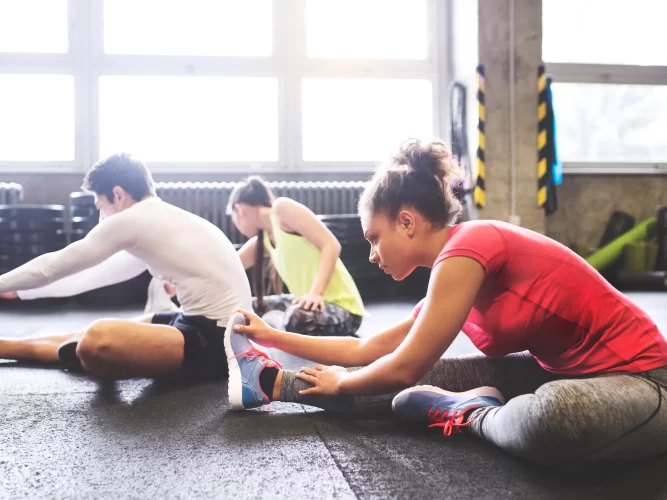Stretching keeps our muscles flexible, strong, and healthy. It is important to look after our muscles so we can maintain good mobility and strength. A lack of stretching can limit your range of motion and tighten your muscles over time.
Here are a few of the great benefits of stretching:
1. Increases flexibility
Being more flexible will help you do everyday activities with ease. It also helps to delay the reduced mobility that comes with ageing.
2. Increases range of motion
Being able to move your joints through their full range of motion helps you maintain your range of movement and independence. This could also slow the degeneration of your joints that comes with ageing.
3. May help decrease the risk of injury
Stretching can decrease the resistance of your body’s muscles during various activities. For example, warming up before a workout and cooling down afterwards is a great preventative measure to avoid injuring yourself and to ensure you’re looking after your body.
4. Improves your performance
If you try doing a squat without stretching first, you will not sink as low, therefore you might compensate for this by leaning further forward which could cause you to injure your back. Whereas if you stretch before a squat, you have a much higher chance of getting the position right the first time, pain-free.
Dynamic stretching before a workout or activity means you’ll be able to perform much better for much longer, increasing the physical benefits from your activity. A flexible joint requires much less energy to move through a wider range of motion and so a flexible body improves overall performance with energy-efficient movement.
5. Improves your posture
Stretching the muscles in your lower back, shoulders and chest helps to keep your back in much better alignment, and therefore improves your posture.
It is muscle imbalances that can contribute to poor posture. Tight muscles can constrict your range of motion and so the likelihood of straining the muscles in your back increases, exacerbating your poor posture.
6. Increases blood flow to your muscles
This results in greater nutrient transportation and improved circulation of blood, which is great for your normal bodily functions.
Chronically tense muscles tend to cut off their own circulation which can mean they’re lacking enough oxygen and essential nutrients to function normally. Stretching can help to get your muscles to relax, allowing this increased blood flow.
7. Calms your mind and relieves stress
Well-stretched muscles hold less tension and can help you feel less stressed. While you stretch, you can focus on mindfulness and connection with your body. Moving your body in an intentional stretching practice will make your mind focus on the task at hand and help soothe your mind. Giving yourself a mental break will help calm you and your muscles.
If you are experiencing stress, your muscles are most likely tense. This is a common physical response to anxiety, or physical or emotional stress. If you focus on stretching out the areas of your body that tend to hold your stress, this will help to loosen your muscles and will contribute to helping you feel better overall.
How To Get Started
It can be difficult to know where to start if you’re new to stretching as part of your routine. However, understanding your limitations and respecting your physical condition is an important initial step. If you’re unsure whether your physical condition may impact your ability to stretch safely, it is recommended to speak with your doctor first. They may even recommend you see a physio for back pain or other specific physical conditions to ensure your safety and comfort.
In order to lengthen your muscles and experience the long-term benefits of stretching, it is recommended to stretch at least 5 to 6 days a week—even on days when you aren’t exercising. It is also recommended to only stretch once you have warmed up your muscles, for example after a walk or light jog. This is because cold muscles are not as pliable, making stretching a lot more difficult. Your local physiotherapist can teach the different types of stretches and the right way to stretch your muscles.
There are two main types of stretching:
Static
This involves holding each stretch in a comfortable position for around 20-30 seconds, while breathing normally and without bouncing. This type of stretching is most beneficial post-exercise to reduce your risk of injury. It is recommended to do around 5-10 minutes of static stretching after your exercise.
Dynamic
This involves more active movements that stretch your muscles, without holding a certain position for a period of time. This type of stretching is usually done before exercise to help your muscles prepare for more intense movement. Aim for around 5-10 minutes of dynamic stretching before any exercise.
Whether you are a seasoned athlete or complete beginner, you can benefit from regularly stretching your muscles. Just 5-10 minutes of the appropriate type of stretching can increase your range of motion, strengthen your muscles, and relax your body and mind.

